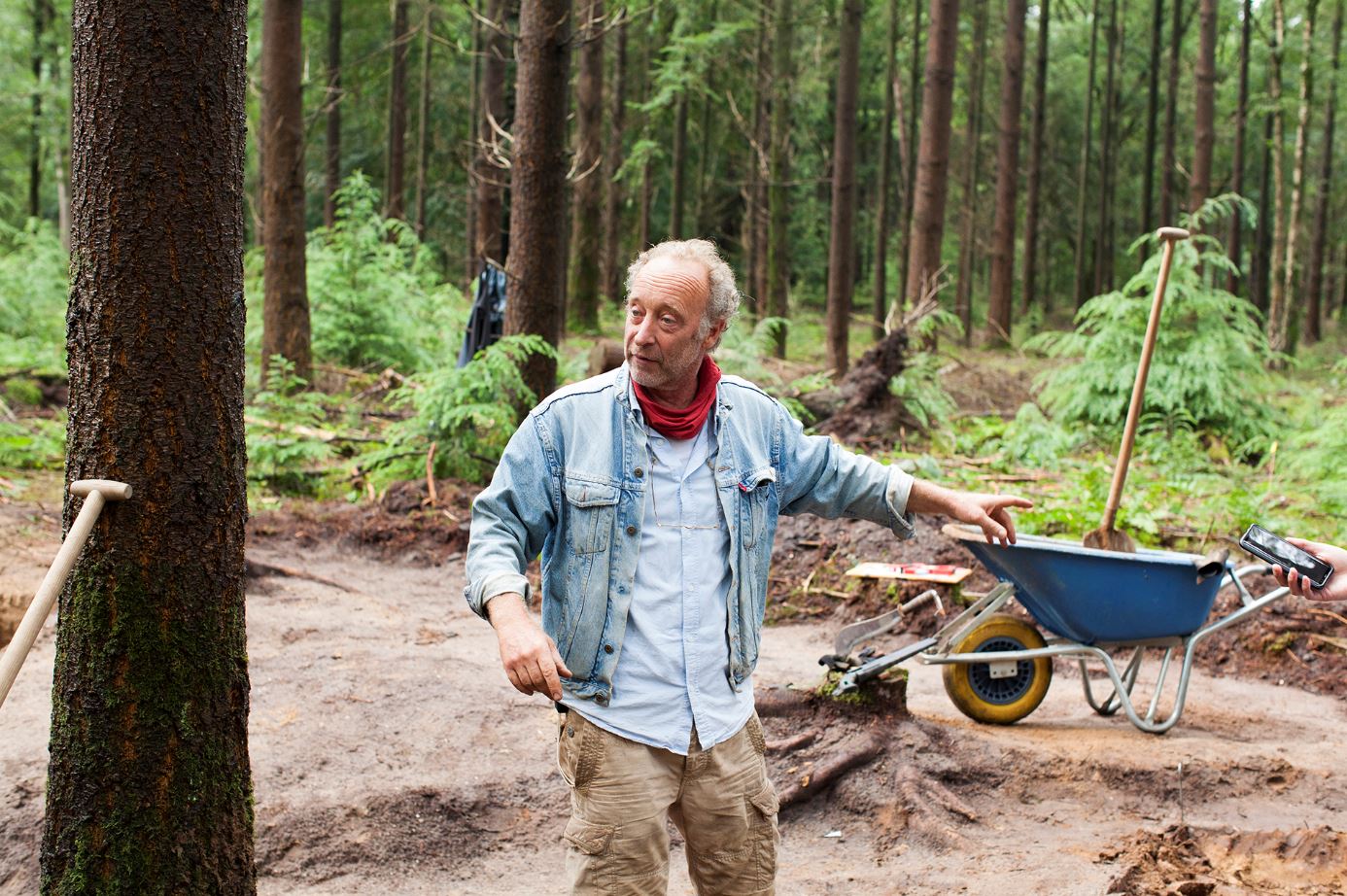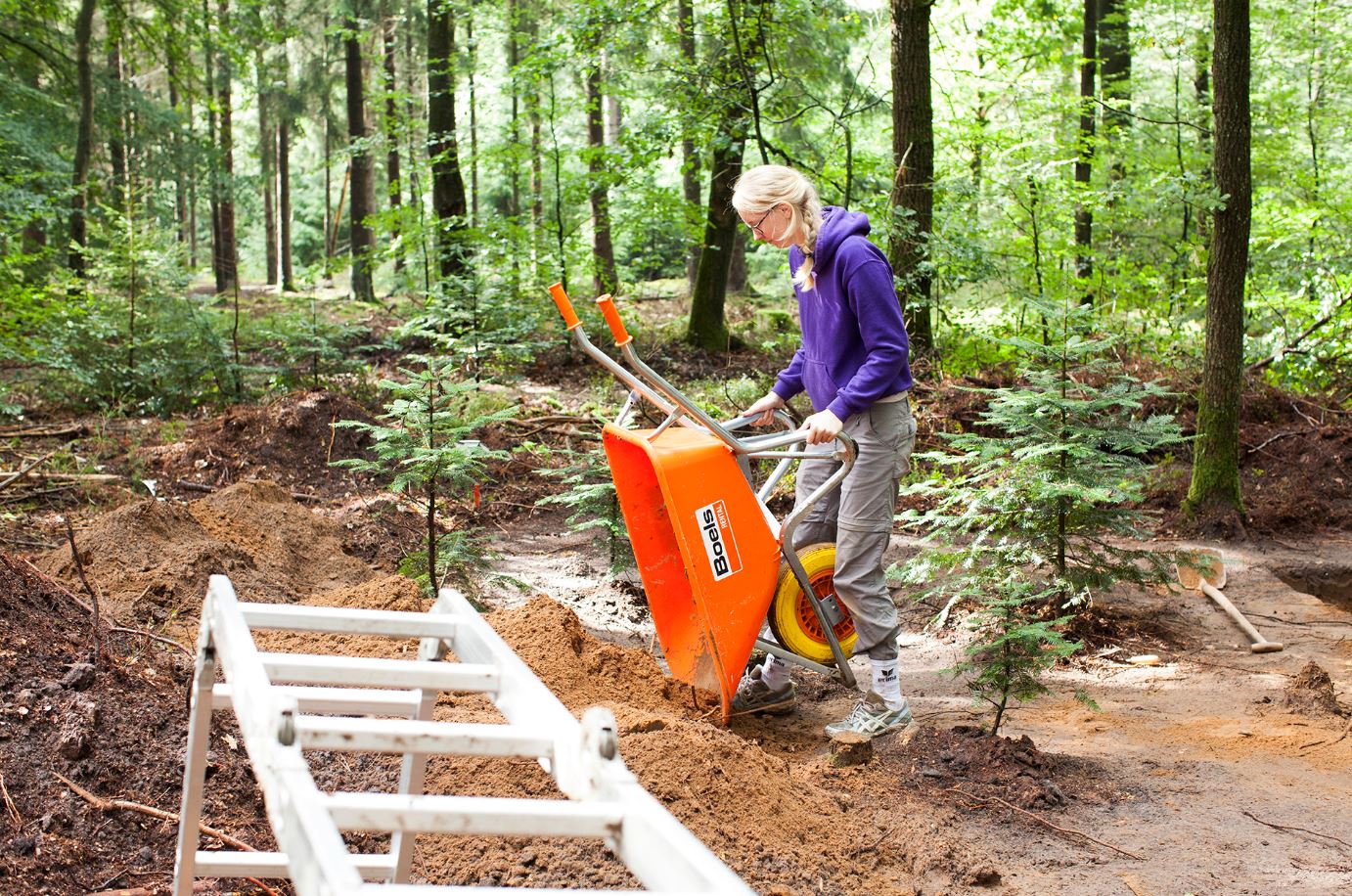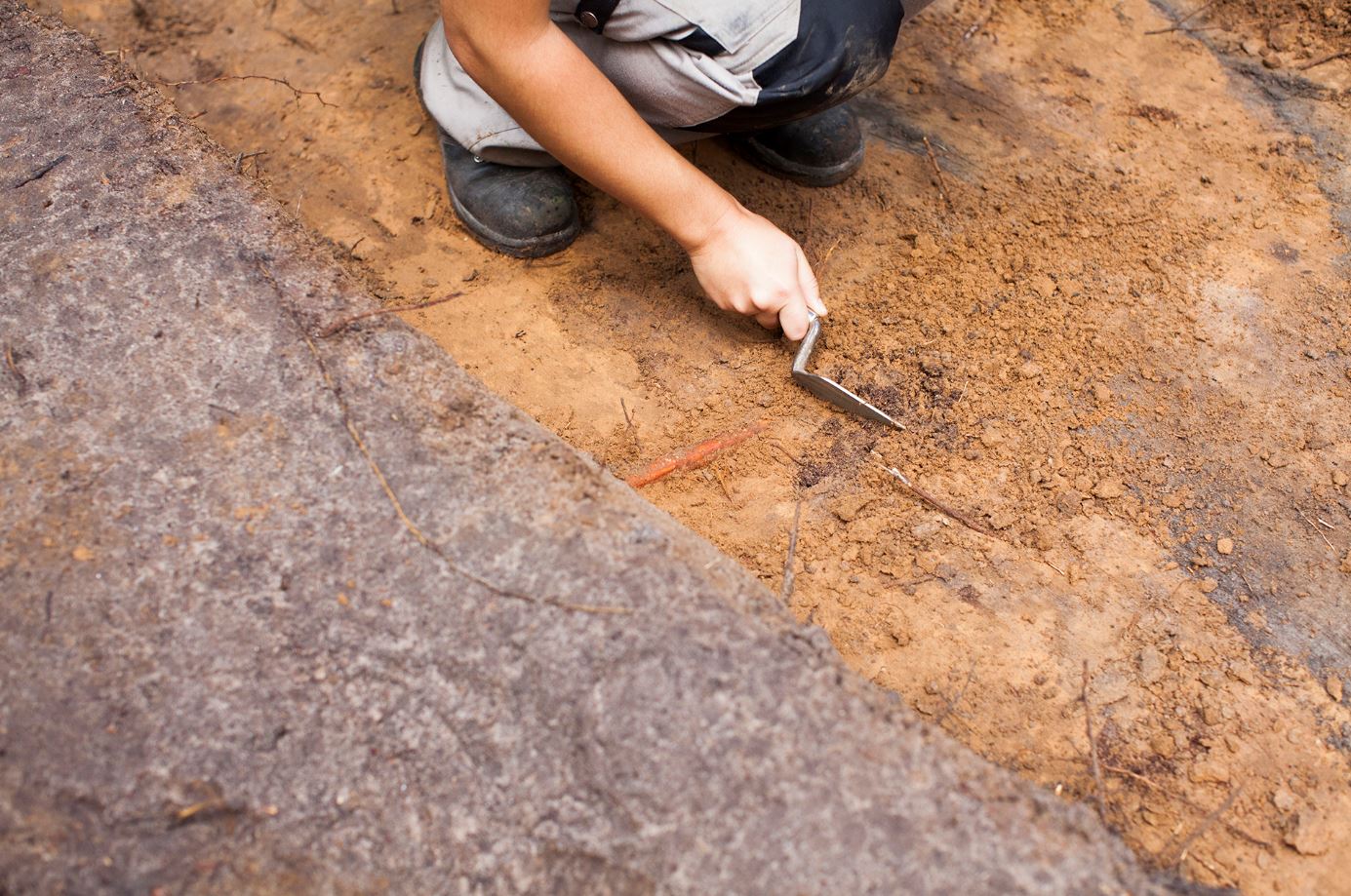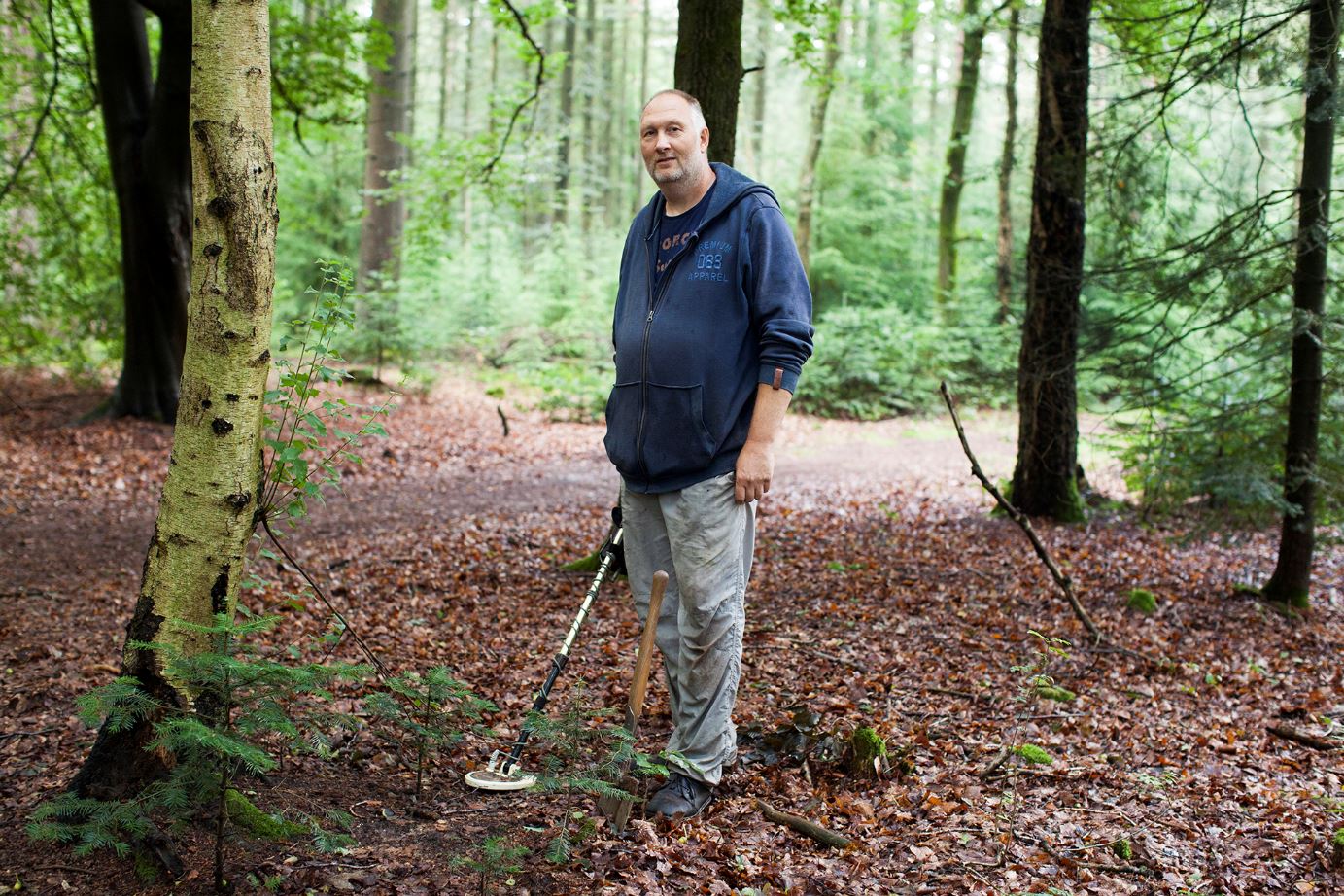
A Roman camp or not? How our archaeologists found the answer
Archaeologists from Leiden University find what is clearly an earth wall and ditch structure in the woods near Ermelo. They suspect it may be the remains of a Roman military camp, but as yet have no conclusive evidence. Will they be able to solve the puzzle?
Deep in the damp pinewoods near Ermelo, people are working hard. A couple of students can be seen among the luxuriant moss and ferns, up to their necks in a narrow trench cut into the forest floor, still holding their spades. They dug the trench themselves over the last few days, intermittently lashed by heavy rain showers.
It’s early September and under our feet is a spectacular piece of history. Or at least, that is the suspicion. We may be standing on a Roman marching camp: a temporary encampment of the Roman army. The only reminiscent feature in the present day is a slight undulation among the trees, where the Roman legionaries may have built a defensive wall. This hillock in the woods will hardly be evident to the untrained eye.
Wouter Verschoof-van der Vaart, a PhD candidate, is the person to thank for spotting this easily missed hillock. Two years ago he was studying the digital height maps of the area, looking for prehistoric burial mounds and fields. He found them near woods here in the Veluwe region, but he also noticed this eye-catching parallelogram-shaped wall, enclosing an area of nearly six hectares. He showed his colleagues, and together they arrived at the theory that it could possibly be a Roman marching camp.

This theory didn’t in fact come out of the blue: nearly a century ago, Leiden archaeologist Jan Hendrik Holwerda found a Roman marching camp just four kilometres from this site. It was a remarkable discovery, because Ermelo is a long way from the Limes, the northern border of the Roman Empire. The camp demonstrated that the Roman soldiers evidently went on expeditions into hostile territory. ‘So it would be incredibly interesting to find a second camp in this area,’ says Mark Driessen, who is leading the dig together with Verschoof-van der Vaart. His rather muddy shorts and denim jacket betray the fact that even lecturers aren’t spared the heavy fieldwork. ‘It would mean that those Roman expeditions weren’t just incidental, but were a structural phenomenon.’
But how do you determine whether these remains are actually Roman, and not just part of a medieval field complex? The answer is that you have to look for ‘smoking guns’, traces in the soil that confirm the Romans lived here, or at least make this theory more plausible. A grant from the Fund for Roman Archaeology has enabled the Leiden University archaeologists to carry out this search in the woods near Ermelo. But the clock is ticking: they only have funding for two weeks of fieldwork. Will they be able to find conclusive evidence in time?
-

Mark Driessen, assistant professor, gives instructions -

The excavated sand is taken away -

A trowel can be used to peel away the soil, layer by layer -

Metal detectors are used to search for bronze objects -

Maurits and Alexander, surveyors
One of the smoking guns may perhaps be hidden in the deep trench in the woods, cutting across the suspected defensive wall and ditch. When you cut through an earth wall in this way, you reveal a cross-section that looks rather like the side of a piece of thousand-layer cake (spekkoek). The bottom layer consists mainly of light-coloured sand, and the top layer mainly of fertile humus, which is much darker.
‘You can see from the wavy lines between the light and dark layers that something interesting is going on,’ says Driessen, pointing to the trench, which might make seasoned thriller fans think of a newly dug grave. ‘Without human intervention, this line would probably have been basically straight, but here you can see clear contours of an earth wall. The lower parts next to that wall have an exceptional amount of fertile humus, probably because those ditches quickly filled up with leaves, branches and other organic material.’
One thing that Driessen, a highly experienced archaeologist, knows for sure: human activity has been involved here. It’s impossible to say with 100 percent certainty whether they were Romans, but it makes the theory much more plausible. A 1,000-metre wall is not something you can build overnight, unless you happen to have around 1,000 toughened legionaries at your disposal. So we can throw out the theory that this is a medieval field complex: it would take a small-scale farmer an eternity to build the earth wall on his own.

Driessen thinks that Roman soldiers were here at a training camp in hostile territory, so that if a real war broke out, they would know how to set up a marching camp. ‘Those Roman legionaries were naturally selected because they were alpha males,’ he says. ‘And it wasn’t advisable to leave those testosterone timebombs languishing in a fort on the Limes; that would just be asking for trouble. Various ancient sources recommend that young soldiers should be kept as busy as possible.’ But the Romans could also have come to the Veluwe region for raw materials: to fell trees for timber, for example.
Yet the shape and size of the defensive earth structure alone is not in itself sufficient proof that it was a Roman camp. Excavations are therefore taking place several metres away. Roman camps traditionally had one or more exits in the defensive wall. There would then often be another small earth wall just in front of that exit, so that enemy troops couldn’t simply storm into the camp. An exit might perhaps have been visible on Verschoof-van der Vaart’s height maps, but the archaeologists aren’t as lucky at this location: the soil profile doesn’t give a definitive answer yet.
We therefore continue the quest, searching for other smoking guns. Maybe the contents of the ditch can be dated using ‘luminescence dating’. This provides an estimate of the age by measuring the radioactivity of sand grains: soil is by nature slightly radioactive, so the longer a grain is in the soil, the more radiation it absorbs. But even this only gives a rough estimate, not exact years. It’s as if you wish your young nephew a happy birthday, for reaching the age of around six to twelve: it’s certainly somewhere near, but it would be better to know his real age.
The holy grail of every archaeologist is therefore to discover ‘cultural finds’, such as pottery, metal arrowheads or tools. Finding a Roman coin, for example, would remove all doubt. But you need a certain amount of luck for that: Roman marching camps were often only used for a few days, which makes it much less likely that objects will have been left behind in the soil.

‘Mark, could you come and have a look at this?’ A rather shy student, wearing scruffy sneakers and socks pulled up over her trouser legs, beckons to her lecturer. We’re standing at the exact centre of the notional camp, and she has been scraping away the forest floor, layer by layer, together with several other students and volunteers. She’s holding in her hand a potsherd about the size of a two-euro coin. Driessen looks at it carefully, and seems fairly interested. When someone asks if this find could be medieval, he answers resolutely: ‘No, this is definitely not medieval.’ But he’s being quite mysterious about what it could actually be. It seems as if he has a suspicion but doesn’t want to give false hope.
A few days later, it is precisely this cultural find that gives a decisive answer. ‘Rejoicing all round here,’ is Driessen’s WhatsApp message on Wednesday 9 September, followed by emoticons of confetti and a champagne bottle. ‘I’m here in the field. Yesterday and the day before, we discovered two Roman bronze finds, and much of the pottery also dates from the Roman period.’
The pottery was found in the upper section of the earth wall and, according to specialists, is ‘non-local’. In other words, it was brought from other parts of the Roman Empire. Another discovery, made with a metal detector, was a fibula, a brooch used by the legionaries to fasten their cloaks.
This establishes with certainty that the wall is a Roman fortification. Now it’s a matter of recording very precisely where all those finds were discovered, so that the follow-up research can take place on the computer. Third-year student Maurits and his buddy Alexander, who has already graduated, spend the entire day walking around with a laser scanner and a mirror on a pole to survey the finds with GPS. This will make it possible to locate again later exactly where the potsherds and fibula were found.
Also read: How two metal detectorists discovered a complete Roman treasure
Two brothers from Brabant discovered more than 100 ancient coins in an ordinary field. The Leiden historian who examined the coins concluded that they were a genuine Roman hoard.
The two surveyors say that they’ve endured some freezing cold nights, because the students sleep in tents at a nearby campsite. ‘But the people make it great fun,’ says Alexander, who is also the group’s drone photographer. He adds, with a smile: ‘And I’ve been on worse internships abroad. Here you at least have running water, electricity and mobile coverage.’ Mark Driessen, assistant professor, also organised a picnic bench with a big tarpaulin, and a second-hand fridge filled with treats.
One student who found it difficult to adjust to the bad weather over the last few days was Jelle. ‘After all that rain, I’m seriously wondering whether I’m cut out to be an archaeologist in the Netherlands,’ says Jelle, who has previously done research in Italy. Perhaps finding a real Roman camp here will make him change his mind.
With special thanks to Maarten Wispelwey, Regional Archaeologist.
Text: Merijn van Nuland
Photos: Melissa Schriek and Alexander C.Q. Jansen
